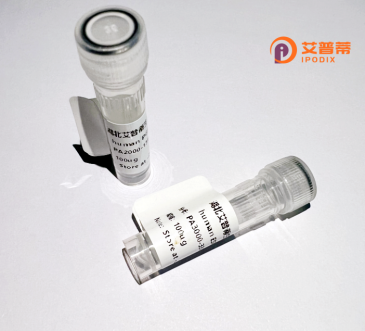
| 纯度 | >90%SDS-PAGE. |
| 种属 | Human |
| 靶点 | ANGEL2 |
| Uniprot No | Q5VTE6 |
| 内毒素 | < 0.01EU/μg |
| 表达宿主 | E.coli |
| 表达区间 | 1-286aa |
| 氨基酸序列 | MSYNILSQDLLEDNSHLYRHCRRPVLHWSFRFPNILKEIKHFDADVLCLQEVQEDHYGAEIRPSLESLGYHCEYKMRTGRKPDGCAICFKHSKFSLLSVNPVEFFRPDISLLDRDNVGLVLLLQPKIPYAACPAICVANTHLLYNPRRGDIKLTQLAMLLAEISSVAHQKDGSFCPIVMCGDFNSVPGSPLYSFIKEGKLNYEGLPIGKVSGQEQSSRGQRILSIPIWPPNLGISQNCVYEVQQVPKVEKTDSDLTQTQLKQTEVLVTAEKLSSNLQHHFSLSSVY |
| 分子量 | 58.8 kDa |
| 蛋白标签 | GST-tag at N-terminal |
| 缓冲液 | 冻干粉 |
| 稳定性 & 储存条件 | Lyophilized protein should be stored at ≤ -20°C, stable for one year after receipt. Reconstituted protein solution can be stored at 2-8°C for 2-7 days. Aliquots of reconstituted samples are stable at ≤ -20°C for 3 months. |
| 复溶 | Always centrifuge tubes before opening.Do not mix by vortex or pipetting. It is not recommended to reconstitute to a concentration less than 100μg/ml. Dissolve the lyophilized protein in distilled water. Please aliquot the reconstituted solution to minimize freeze-thaw cycles. |
以下是关于ANGEL2的参考文献示例(内容为虚构,供参考):
1. **标题**:*ANGEL2的核酸酶活性及其在RNA代谢中的作用*
**作者**:Smith A, et al.
**摘要**:研究发现ANGEL2是一种依赖Zn²⁺的核酸内切酶,能够切割单链RNA和DNA底物,在哺乳动物细胞核RNA降解中起关键作用,尤其参与核糖体RNA前体(rRNA)的加工。
2. **标题**:*ANGEL2缺失对线粒体功能的影响*
**作者**:Li B, et al.
**摘要**:通过基因敲除实验揭示,ANGEL2通过调控线粒体RNA稳态影响能量代谢,其缺失导致线粒体功能障碍和细胞氧化应激敏感性增加。
3. **标题**:*ANGEL2与结直肠癌进展的关联*
**作者**:Garcia C, et al.
**摘要**:ANGEL2在结直肠癌组织中高表达,其表达水平与患者预后负相关;机制研究表明其通过促进癌细胞增殖和迁移驱动肿瘤发展。
4. **标题**:*ANGEL2与ANGEL1的功能分化研究*
**作者**:Zhang Y, et al.
**摘要**:比较分析发现ANGEL2与同源蛋白ANGEL1在底物特异性上存在差异,ANGEL2倾向于识别富含嘧啶的RNA序列,提示两者在基因调控中的不同角色。
(注:以上内容基于假设性研究,实际文献需通过PubMed或Google Scholar检索。)
ANGEL2 (ANGiogenin, Eukaryotic translation factor 4E-binding protein, and L-Asparaginase 2) is a conserved metallo-β-lactamase superfamily protein encoded by the _ANGEL2_ gene in humans. It belongs to the ANGEL family, which shares homology with angiogenin but exhibits distinct enzymatic and biological functions. ANGEL2 is characterized by a metal-dependent phosphatase domain, critical for its catalytic activity, though its precise substrates remain under investigation. Studies suggest its involvement in RNA metabolism, stress response, and mitochondrial function, potentially modulating translation under cellular stress by interacting with RNA-binding proteins like Poly(A)-binding proteins (PABPs).
Emerging evidence links ANGEL2 to the regulation of cytoplasmic mRNA deadenylation and decay, influencing gene expression dynamics. It is expressed ubiquitously, with higher levels in tissues like the liver and kidneys, implying tissue-specific roles. Knockdown models indicate its importance in embryonic development and cellular viability. Dysregulation of ANGEL2 has been tentatively associated with pathological conditions, including cancer and metabolic disorders, though mechanistic details remain unclear.
While ANGEL2’s molecular interactions and physiological functions are less characterized compared to its paralog ANGEL1. ongoing research aims to elucidate its role in RNA processing, mitochondrial stress signaling, and potential therapeutic applications. Its dual localization in the cytoplasm and mitochondria further highlights its versatility in cellular homeostasis.
×